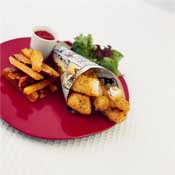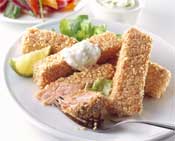FISHY STORY - Fish goujons with sweet potato chips / Sesame crusted salmon
 Continuing our ‘back to school’ theme, parents trying to juggle the nutritional needs and wellbeing of children both in and out of school might take a look at the BIM leaflet entitled ‘Tots to Teens’, highlighting the positive benefits of fish in childrens’ diets. It is available through GPs, dietitians, fish retail outlets and on request from BIM Tel: +353 (0)1 214 4214 (or by visiting www.bim.ie/wellbeing), and is the latest in a series of information leaflets on seafood nutrition for all ages.
Continuing our ‘back to school’ theme, parents trying to juggle the nutritional needs and wellbeing of children both in and out of school might take a look at the BIM leaflet entitled ‘Tots to Teens’, highlighting the positive benefits of fish in childrens’ diets. It is available through GPs, dietitians, fish retail outlets and on request from BIM Tel: +353 (0)1 214 4214 (or by visiting www.bim.ie/wellbeing), and is the latest in a series of information leaflets on seafood nutrition for all ages.
“Most of us know about the health benefits of including fish as part of our diets,” says Helen Brophy, Market Development Manager with BIM. “But we don’t often think about it as an important, healthy food that has special benefits for children. Fish is a rich source of protein that is essential for rapidly growing bones and muscles and it is very easy to digest and gentle on children’s stomachs. All kinds of fish are rich in minerals like zinc, selenium and iodine that healthy bones, muscles and immune systems require for proper development. In addition, the Omega-3 fats found in oil-rich fish such as trout and mackerel are essential for brain development.”
Some other positive aspects of fish for children may not be well-known – for example, several studies have found that children who regularly eat fish, especially oil-rich fish, have a significantly lower risk of developing asthma; and dyslexia in children have been linked in some studies with a lack of Omega-3 fats, and the leaflet also gives helpful advice about how to include fish in their diets. “We understand that many parents will have difficulties in getting their children to eat fish,” explains Helen Brophy. “Most children refuse foods at some stage – usually between the ages of two and three. The leaflet outlines some helpful hints and gives some child-friendly recipest. Many of us can recollect being forced to eat something as children and how this affected our fondness for that particular food, we would not recommend forcing children to eat fish, this is usually counterproductive.”
Helpful hints:
• Start to introduce white fish like whiting and haddock, which have a milder flavour. As your child gets used to the fish you can add in new varieties and start introducing the stronger tasting oil-rich fish like salmon
• Remember to eat fish yourself. Most children will copy what the see their parents doing – if they see you eating and enjoying fish, they are more likely to try it themselves
• Offer fish to children as early as possible. Fish is an ideal food for weaning – take care to remove all the bones
• Do offer fish at least once a week. It can take time for children (and adults) to get used to the new taste and texture of fish.
Fish goujons with sweet potato chips
 Fish & chips with a difference – and older children will enjoy making this attractive and straightforward dish themselves. The sweet potatoes suggested are trendy at the moment but Irish-grown potatoes like Roosters could be used instead (see Ingredient of the Week below).
Fish & chips with a difference – and older children will enjoy making this attractive and straightforward dish themselves. The sweet potatoes suggested are trendy at the moment but Irish-grown potatoes like Roosters could be used instead (see Ingredient of the Week below). Serves about 3-4, depending on age:
450g/ 1 lb gurnard fillets (or other firm white fish fillets),
skinned & any bones removed
2 large sweet potatoes
1 tablespoon olive oil
Squeeze of lemon juice
Sprinkling of salt and freshly ground pepper
2 tablespoons runny honey
A few handfuls of fresh breadcrumbs
Preheat a fairly hot oven, 190°C/gas mark 5
Cut the sweet potato into chips, cook in the microwave for 2 minutes on a high setting
Remove from the microwave and toss in olive oil, then roast in the preheated oven for 10-15 minutes
Meanwhile, cut the fish into 5-7cm/2-21/2” strips and place in a large bowl; add lemon juice and seasoning. Add the honey and stir gently to coat the fish pieces
Toss the fish in the breadcrumbs. Place onto a lightly oiled ovenproof tray, bake for 8 –10 minutes until golden brown.
Serve with the sweet potato chips, salad and tomato ketchup dip.
SHORT RECIPE: Sesame crusted salmon
 You could also use white fish fillets for this simple dish, and the sesame seeds could be replaced with oatflakes if preferred.
You could also use white fish fillets for this simple dish, and the sesame seeds could be replaced with oatflakes if preferred. Serves about 3-4, depending on age:
450g/1lb firm fish fillet, eg salmon
4 tablespoons sesame seeds
Splash of olive oil for frying
Salad leaves
Ketchup or mayonnaise
Cut the fish into thick 5-7cm/2-21/2” long strips
Place in a bowl with the sesame seeds or oatflakes and gently mix until all the fish is coated (You may need to press the fish into the seeds to help them to stick).
Heat the oil in a non-stick frying pan, and add the fish
Fry over a medium heat turning gently until all the sides are golden and crispy
Remove and drain on absorbent kitchen paper.
Serve with tossed salad and ketchup or mayonnaise.
INGREDIENT OF THE WEEK: THE ROOSTER
 What Is It?
What Is It? The Rooster is Ireland’s most popular and versatile variety of potato. It is a main crop potato, just coming into season now and has a great combination of qualities to suit both farmer and cook: it is a good yielding, disease-resistant variety that washes well to reveal a pretty skin, and keeps well too; the creamy flesh is floury enough to please the Irish taste for ‘balls of flour’ but not so floury that it breaks up too easily during cooking. All this, and good flavour too: the perfect all-rounder.
Where Does It Come From?
The Rooster was bred at Teagasc, Oakpark in Co Carlow; it was first planted in 1991 following nearly a decade of farm trials – and the name of this attractive glossy red-skinned potato was inspired by a fine red rooster in the yard of one of the farmers growing the trial crop. Now not only is it one of our most popular potatoes, but it is being grown as a speciality crop in Scotland - where its unique claim to fame is that it was served as a ‘gourmet potato’ at the G8 world leaders summit last year.
Where Can I Get It?
Happily, the great success of the Rooster means that it is available in every greengrocers, corner shop and supermarket in Ireland. It keeps so well that it is on sale virtually all year, but it pays to check the quality especially now that the new season crop is being released; the ‘old’ ones may not be bad, but fresh ones will be much better.
What Can I Do With It?
The best thing about the Rooster is that it is suitable for virtually any cooking method used for potatoes: it bakes, steams and boils well without breaking up easily, and looks attractive served in its jacket. It slices well to use as a topping, and makes lovely mashes of all kinds – champ, colcannon, potato cakes and all their relatives such as boxty. And then there are all the chowders and potato soups…Best of all, perhaps are the oven wedges: heat the oven until it is very hot; meanwhile scrub your Roosters and cut them into wedges – say eight for a medium-large potato; cover with cold water and a little salt, bring to the boil and par-boil (about 2-3 minutes) then drain well. Add a good splash of olive oil to a roasting tin and heat well in the preheated oven, then swirl the potato wedies around in it, drizzle with a little more olive oil and sprinkle with sea salt. Roast for about 10-15 minutes until golden brown and crisp, tossing once or twice if convenient: delicious.






There are currently no comments
Leave a comment
Not a member? Register for your free membership now!
Or leave a comment by logging in with: